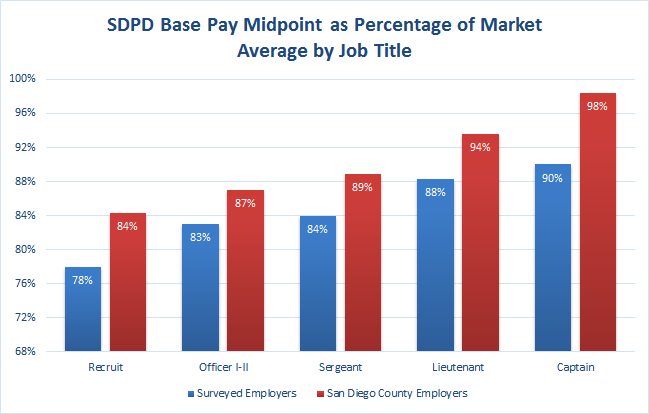Deficient Recruitment Efforts, Not Low Pay, Responsible for SDPD’s Staffing Shortage

“The San Diego Police Department is woefully understaffed and has clearly shown, over an extended period of time, it cannot correct its staffing crisis without increasing the compensation of sworn police officers and recruits.” – Jeffrey T. Jordan, VP, San Diego Police Officers Association
On the contrary, the San Diego Police Department’s (SDPD) current staffing shortfall is the result of repeated City decisions that have prevented thousands of prospective recruits who wish to serve from doing so.
Presently, the department is short approximately 250 officers from its 2018 targeted goal of 2,128 budgeted sworn staffing positions.
This shortfall, rather than being caused by uncompetitive salaries that are insufficient to attract or retain officers, is the result of events that demonstrate just the opposite — the City stopped or greatly reduced hiring in the face of thousands of prospective recruits willing to join. Specifically, the City cancelled or reduced scheduled academy classes that would have otherwise brought in over 400 new officers since 2004, more than enough to completely alleviate the current shortfall.
The City’s Independent Budget Analyst Office (IBA) reported that during 2004 and 2005 the City canceled five budgeted academy classes which “could have resulted in an infusion of 150-175+ new recruits.”
In retrospect, this cancellation could not have occurred at a worse time. The City would experience a higher-than-expected attrition rate in the coming years — driven predominantly by officers leaving for retirement.
In 2007, the IBA warned that 251 officers would take advantage of the Deferred Retirement Option Plan (DROP) in the next five years and that retirement would be the largest component of officer attrition going forward. They further advised that:
It could take 3-5 years to return to more typical sworn staffing levels. This will depend largely on the City’s ability and efforts to recruit new qualified candidates. (Emphasis added.)
Unfortunately, the City’s ability to recruit new candidates would be seriously compromised when budget decisions in FY2009 and FY2010 resulted in the City cutting its quarterly academy class sizes from 50 to 25. In FY2011 the City cancelled all but one academy class, a decision that “resulted in a lost opportunity to add approximately 57 additional recruits.”
And what did happen after the hiring freeze of 2011 ended? The SDPD received over 3,000 applicants for just 25 positions in its first academy class of 2012, according to 10News. This is symptomatic of a larger trend – a tremendous, unmet demand to work in law enforcement in the San Diego area. For example, the following year the nearby San Diego County Sheriff’s Department received over 4,000 applicants for their 275 deputy positions.
Further, when the City authorized increasing the academy class size to 43 in FY2015, the first class easily reached capacity, with 41 new recruits and an additional five officers who are leaving other agencies to come work for the SDPD. (Classes are authorized to accept slightly more than the budgeted amount of 43 to accommodate for potential drop-outs.) With four classes scheduled for the year, up to 172 new recruits could be added by close of FY2015.
The Data
Despite an abundance of prospective recruits eager to work for the SDPD at current compensation levels, the union has seized upon the current shortfall as an opportunity to lobby for higher wages. The union has long stated (as far back as 1985) that paying salaries less than competing agencies will result in a high rate of attrition as SDPD officers leave for greener pastures elsewhere.
Yet recent data reveals this is simply not true. Over the last five years, the SDPD lost an average of 103 police officers a year, with only 13 a year going to other agencies. Even assuming that all officers leaving for other agencies left for higher pay, this represents only a small minority of SDPD departures, and less than 1 percent of the entire force lost to other agencies per year.
Recent increases in the overall attrition rate is overwhelmingly driven by an increase in retirement — in both 2013 and 2014 retirement accounted for 60 percent of the attrition rate, with officers leaving for other agencies accounting for only 10 percent of departures.
The San Diego County Sheriff’s Department is frequently cited by the union as a potential poacher for underpaid SDPD officers. Yet the Sheriff’s attrition data says otherwise. Since 2010, only a total of 17 SDPD officers transferred to the Sheriff’s Department, with 11 arriving in 2014. However, the Sheriff’s Department itself lost 16 officers to other agencies in both 2013 and 2014. This would suggest that the SDPD’s recent attrition rates are not the result of an SDPD-specific crisis, but are in line with similar agencies of their size and region.
Nonetheless, the City implemented an officer retention program beginning in 2014 that authorized a seven percent raise in non-pensionable pay over the next five years for all sworn officers.
Additionally, the City expanded its officer retention program in 2015 with a $3.2 million expenditure for increased overtime pay. Despite this, a recent study comparing SDPD compensation with other California agencies has prompted everyone from the union to the Mayor to call for further pay increases.
Notably, the summary findings from the study compares base pay ranges only, which omits the 7 percent salary increase in non-pensionable pay and additional overtime authorized for the SDPD beginning in FY2014. It thus overstates the pay disparity reported.
Further, the study’s surveyed employers include cities from entirely different markets, such as San Francisco, Oakland, and San Jose. In addition to being located in opposite ends of the State, the Bay Area cities have dramatically higher costs of living than San Diego. Consequently, the average salaries of all government employees in these cities, not just police officers, are significantly higher than those found in San Diego or the San Diego area generally.
A more meaningful comparison would be restricted to competing agencies in the San Diego area only; doing so greatly reduces the pay disparity found.
The study reported that the SDPD’s base pay midpoint ranged from 78% to 90% of the “market” average, as represented by the blue bar in the chart above, with the “market” defined as the 19 statewide employers surveyed. However, if the comparison is restricted to the six cities located within San Diego County plus the San Diego County’s Sheriff Department, the SDPD’s base pay ranges from 84% to 98% of the average.
The Theory
Even if the current staffing shortfall is not caused by low pay and even if officers going to other agencies are a much smaller component of attrition than retirement, should not SDPD salaries be increased to parity with nearby, competing agencies?
Two factors are important when considering this question. The first is that such a salary policy would guarantee ever-increasing levels of public pay and taxation. It would entail every agency presently paying “below market” rates increasing its pay to the higher rates paid by other agencies, which in turn will now use that level as its salary baseline, which the follower-agencies would then seek to match, and so on and so forth.
Additionally, the argument assumes that competing agencies are capable of absorbing any and all lower-paid police officers. There are, however, only a finite number of positions at competing agencies. So the idea that any imbalance in pay would result in a mass exodus from one agency to the other is simply not plausible.
Decisions whether salary levels are adequate should be based on whether or not sufficient talent is being attracted, and subsequently retained, at current salary levels. We have seen the SDPD has no trouble attracting an excess of applicants and recruits, when the city chooses that course. Additionally, the number of officers leaving for other agencies has been extremely modest over the past five years, never representing even 1 percent of the force in any given year.
The first half of FY2015 data does project that 24 of this year’s projected 136 departures will leave for other agencies. This mild uptick is likely attributable to the recent increase in hiring authorized by the Sheriff’s Department and other agencies that are seeing their budgets return to pre-recession levels. As noted above, this pull is not something perpetual that can go on indefinitely.
Even in an abnormally higher year, the number of officers leaving for other agencies is a small fraction of the total attrition rate, and represents a mere 1.3 percent of the total force. Is it really appropriate to implement agency-wide pay raises for such a small minority, particularly when thousands of willing applicants want to join the ranks at current pay levels?
Conclusion
With half of the force eligible for retirement by 2017, it is likely the attrition rate will continue to grow in the coming years.
To address its staffing shortfall without creating an unnecessary additional burden on taxpayers, the City has several options. It can:
- Maintain or modestly expand academy class size while continuing to focus on improving recruitment methods.
- Prioritize the importance of recruitment to avoid eliminating or reducing academy classes in future years.
- Reform pensions to encourage the most experienced and valued officers to stay past the average SDCERS Safety retirement age of 51. A change to pension formulas that would allow for maximum benefits to be received at 55, instead of 50, would help. Benefits could still be available as young as 50, but on a sliding penalty scale similar to what Social Security employs.
- Consider implementing service contracts for new recruits that incentivize them to stay with the SDPD for a set period of time.
In sum, the current shortfall is predominantly caused by two features: an artificial restriction on the supply of available labor and an abnormally high rate of retirement incentivized by lucrative pensions that average $94,425 a year.
Ironically, not only will an increase in pensionable compensation fail to address the true cause of the problem, it will further exacerbate the city’s primary cause of attrition – retirement – by increasing the average pension and corresponding incentive to retire early.
The claim that the SDPD’s staffing shortfall was created because of low pay contradicts all available evidence. Policies based on this claim will not only fail to address the source of the problem, but also create an unnecessary financial burden for the City and its taxpayers.
About the Author: Robert Fellner is Research Director for TransparentCalifornia.com, a joint project of the California Policy Center and the Nevada Policy Research Institute.

